In total, 88% of Latvian companies collectively celebrate the birthdays of colleagues or employees in the corporate workplace. Only 3% of respondents indicated that their company does not celebrate employee birthdays in any way, and in 9% of cases, colleagues birthdays are celebrated only on the initiative of their closest colleagues, and even then, the gift is purchased individually. This is the gifting culture example from Latvia, collected from a survey conducted by FromMe.lv.
FromMe.lv is a gift card business that offers a wide variety of gifts for any occasion. As they are gift experts, they’ve conducted a survey to find out what the gifting culture is like in the corporate world.
In this article find out more about the FromMe.lv survey on the gifting culture in Latvian corporate world.
For your convenience, we have added a table of contents with active links that will take you to the section you are interested in.
- About the survey
- About the survey respondents
- Gift value
- Different traditions for greeting colleagues
- Challenges in finding a gift
- Where to find help with gift ideas
- Evaluation of the current system
About the survey
The purpose of the FromMe.lv survey is to gather data regarding various coworker and employee birthday gifting traditions and to measure how satisfied employees are with their gifts. We are particularly interested in this question because we believe the data they gathered and the responses they received are interesting and valuable.
Between January and July 2018, 173 respondents from different companies answered the questionnaire. Respondents have given their personal opinion and assessment of their company’s system of coworker gifting traditions. So the survey did not ask for the name of the company, but only for the industries and company size that is represented.
In this article, we will present a summary of the current results by the main questions covered.
About the survey respondents
The companies represented by the survey participants come from different industries and are of different sizes. This diversity ensures that we can learn about the different gift-giving traditions that exist in both large and small companies. As well as industries ranging from IT and financial services to cultural institutions.
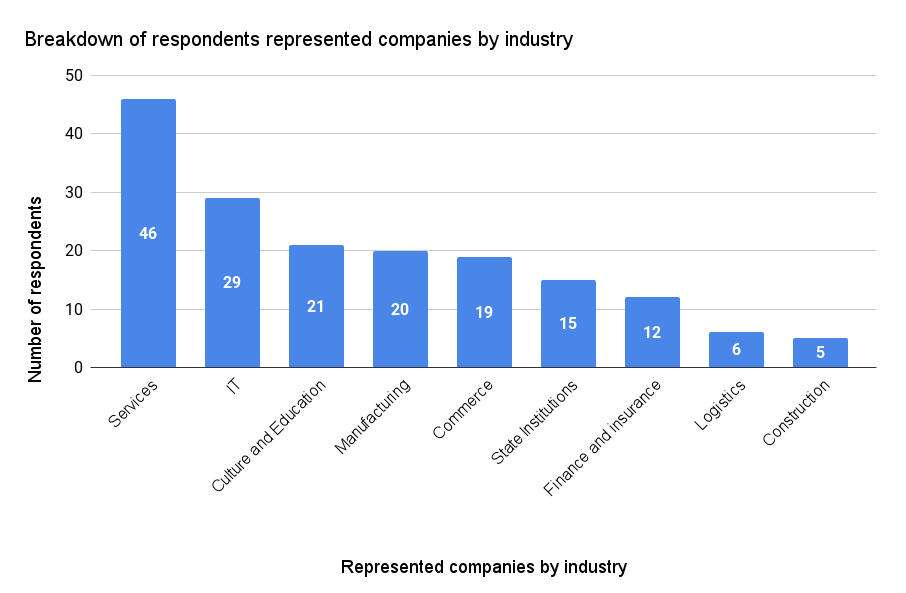
The service industry is the most represented, with 46 respondents (27%), and includes a wide range of service providers such as catering, public relations, marketing, tourism, leisure, etc.
29 respondents (17%) represent the IT sector and roughly similar numbers represent culture and education (12%), manufacturing (12%), and commercial enterprises (11%).
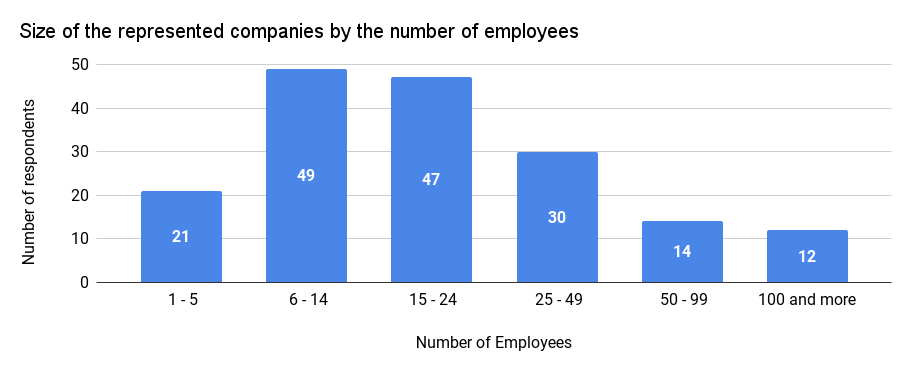
85% of respondents represent small and medium-sized enterprises with up to 50 employees. Of course, companies with 1 to 5 employees are much more represented in Latvia. But for this survey, 12% representation is sufficient – slightly higher than the average representation of large and medium-sized companies.
FromMe.lv has chosen this breakdown of companies by the number of employees from the point of view of the cohesion of colleagues and day-to-day cooperation.
A few comments on each of the employee groups
1 – 5 employees: a team that works side by side daily and knows each other very well. For a company of this size, it is often not relevant to introduce a uniform approach to gift-giving culture. At the same time, a small team makes it possible to create very interesting, personalized and surprise-oriented greeting traditions.
6 – 14 employees: a team that still knows each other well. There are likely no multiple levels of subordination in the company. Therefore everyone works as a team and the gift-giving culture is organized in a unified way.
15 – 24 employees: a team that could be made up of several smaller teams with their distinct traditions. If all colleagues were involved in generating ideas for gifts for colleagues, it would be difficult to agree on one gift.
25 – 49 employees: a team that already has a defined organizational structure with several teams. Colleagues are more likely to know each other and would be happy to wish each other a happy birthday. Even with a handshake and a kind word. A common approach to greeting colleagues would be desirable to avoid unnecessary misunderstandings and resentments.
50 – 99 employees: relatively large companies with different departments where employees might not know each other and do not interact with each other daily.
100 or more employees: large companies.
Gift value
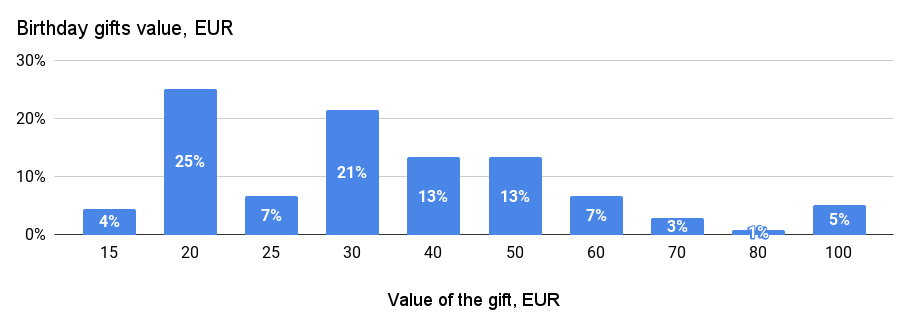
The majority (88%) of respondents confirmed that their company organizes birthday celebrations for colleagues. 9% of respondents admitted that their workplace team does not organize joint greetings. Only as many as each person can come up with to greet their closest colleagues.
But 3% said that their company does not congratulate colleagues at all. The most typical value of a birthday present is EUR 20. 25% of the companies surveyed, gift presents of this value. This is the most popular gift value both in companies where the gift is arranged by the employees together and where the gift is given by the company.
The following most popular gift value is EUR 30. Gifts with value up to EUR 30 are chosen by 58% of the teams (counting gifts between EUR 15 and EUR 30). It is also worth mentioning that 5% of companies give a colleague a birthday gift valued approximately EUR 100. It would be interesting to see whether these results would hold with a larger number of survey respondents.
As FromMe.lv mentioned in their research, many respondents indicated that greater presents are given for larger anniversaries or other celebrations. But that is not included in these statistics.
Different traditions for greeting colleagues
A gift-giving tradition is a set of responsibilities and actions that are practiced within a particular work team to congratulate colleagues on birthdays and other occasions. This set of responsibilities and actions has several characteristics, which we will discuss further.
Of course, the size of the firm, the size of the team, the type of teamwork, the company premises, and other factors all have a significant impact on the gift-giving tradition.
The main features of the gift-giving tradition are the questions we seek to answer:
- How often are birthdays celebrated?
- Who pays for the gift?
- Who organizes a celebration for colleagues?
- Who seeks and chooses a gift for a colleague?
- How is the money raised?
- How is the celebrant greeted?
1. How often are birthdays celebrated
Birthdays are typically celebrated on a specified day. This ensures that the birthday is honored on the appropriate day when wishes and congratulations are most welcome.
There are occasions when the greetings take place once a week when the whole team gets together. The weekly celebrants are then congratulated.
In this situation, it’s great that the entire staff is present and enjoying the moment while sharing a slice of cake and chatting. What isn’t nice is that this form of greeting does not necessarily occur on the birthday of the person being celebrated, but rather shortly before or after.
There are collectives that congratulate the celebrant on the last Friday of the month, or during the monthly general meeting. This is more common in corporations that purchase celebratory gifts for employees and uses the general meeting for public congratulations and presentations.
2. Who pays for the gift
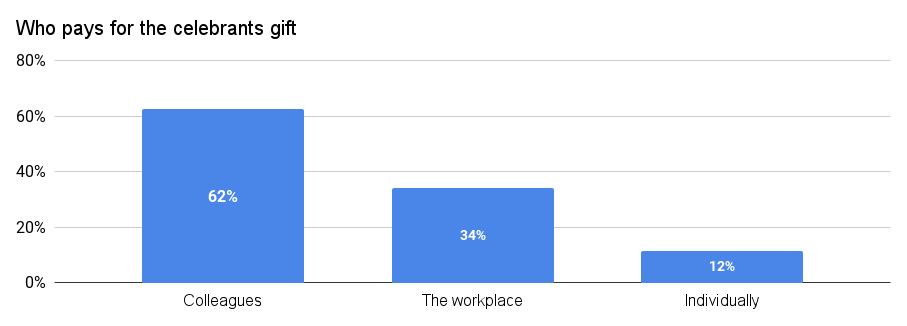
The majority (62%) of work teams purchase gifts for coworkers. A significant number (34%) of companies have taken this responsibility on themselves.
Flowers, cake, a bottle of wine, or a gift card are common corporate gifts. On many occasions, the company will take care of the table setting. Allowing the birthday person to enjoy the big day even more. In around a third of cases where the company gives the employee a gift, colleagues also organize the purchase of a separate gift (8% of all respondents).
In 12% of the companies surveyed, there is no joint greeting of a colleague. This is done by each individual according to their preferences and possibilities.
A joint greeting is organized in some of these circumstances, however, this only applies to major celebrations or life events. Such as the birth of a child. Some companies do not celebrate at all because no one pays attention or has taken the initiative to organize it. Rather focusing on the work that has been completed.
3. Who organises a celebration for colleagues
Is there someone in the team who is responsible for greeting colleagues? If there is someone in charge, then greeting colleagues is an organised process. It is also important which colleague is responsible and why.
It makes a difference in our opinion whether the person in charge has volunteered to organize the greeting. Because he or she enjoys it and is good at it, or whether it is an obligation. Of course, it’s not all black and white, so you can see below who the people in charge usually are.
According to the survey results, 69% of organizations with a gift-giving and greeting culture have a person in charge of greeting colleagues. This person is not always in charge of the entire process. That is from the conception of the gift to its presentation. But the overall responsibility is in the hands of one person to ensure that the colleague’s greeting is not forgotten.
In a number of companies this responsibility and duty is rotated from employee to employee. While in other companies it is determined specifically which colleague is responsible for this task.
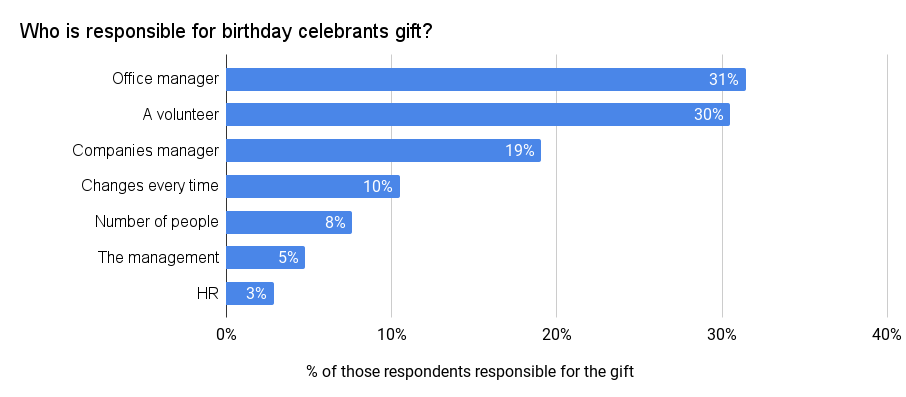
In 31% of cases, the office manager is in charge of greeting gifts. This is largely owing to the fact that he or she is the most familiar with all of the company’s personnel. And it also has some overlap with her job responsibilities.
This is the team member best suited to keep track of the list of jubilees and organize everything. Practically as often, this responsibility is taken on by a volunteer. Either someone who is the most active or someone who is good at the gifting process.
(More on this in the next section)
It is relatively common for this role to be taken on by the head of a company or department. This seems to be an excellent alternative because it is a great approach to demonstrate an interest in establishing a positive team climate and relationships with each employee. However, this responsibility should be assessed according to the size and sector of the company.
In 10% of cases, the person in charge changes according to a fixed schedule. While in 8% of cases, several employees are given this responsibility at the same time. It is like setting up a special committee for colleague greetings, where each peer is responsible for different tasks. For example – one collects the money and buys the gift, while the other presents it.
4. Who seeks and chooses a gift for a colleague
Who decides on what to gift – is it the employee who has the responsibility? Does it involve several colleagues, or does the whole team get involved?
The responsibility for remembering anniversaries and buying gifts is a fairly technical one. But choosing a gift is challenging for many teams. FromMe.lv identified who is responsible for making gift suggestions, picking the ideal gift, and coming up with creative ways to congratulate a colleague based on the respondents’ responses.
It should be mentioned that 26% of the companies that practice the gift culture have a standardized gifting system. So a lot of thinking is out of the question.
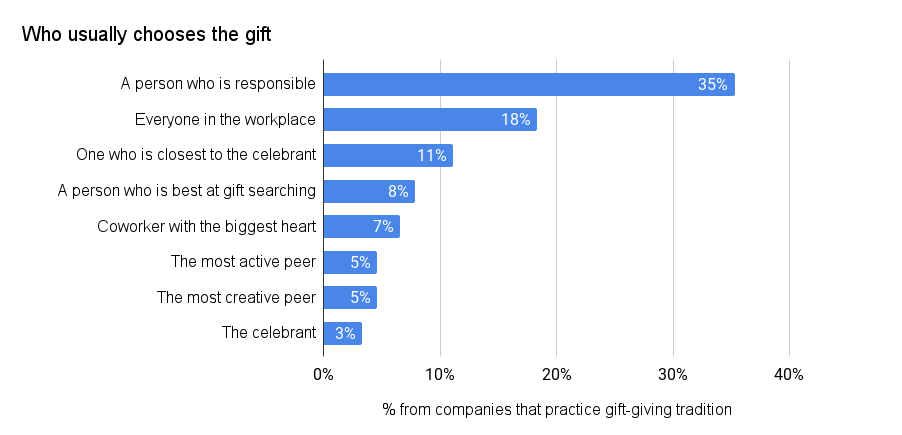
Most often, the employee who is responsible for greeting the celebrant is also the one who has to think of a gift idea. This is the case in 35% of companies that have a celebrant greeting traditions.
All employees
In 18% of cases, all employees are involved in choosing the gift. And in 11% of cases, those who know the employee the best are involved. Those who know the individual better are more likely to inform about the colleague’s hobbies and interests. Or what is more vital and needed in a certain life situation.
It is also critical to determine whether the item the team wishes to give the individual does not already exist. Because the closest colleagues are acquainted with the colleague’s family, they are frequently involved.
Creative employees
Often the most sincere, creative, and active people in the team are involved in choosing the gift. As they usually are full of ideas and know how to turn even mediocre ideas into a great gift. It’s beneficial to have someone on the team who enjoys and is successful at coming up with gift ideas.
There are teams where each colleague’s wants are determined at the start of the year so that they know what to gift them. Or where they are particularly asked what they want before their birthday.
5. How is the money raised?
Often the purchase of the gift is organized and financed by the celebrated person’s colleagues. In that case the task of raising money is inevitable.
From the respondents answers, FromMe.lv have summarised the following ways.
Monthly payment into the gift budget
One person is in charge of the cash register. And its contents and tells all colleagues how much is due each month. Payments are made in cash, to the account of the person responsible. Or a special account set up for this purpose.
This is one of the most efficient systems for collecting money. The biggest challenges are keeping track of whether everyone has paid and caught up with those who have not.
The money is collected in a set budget amount before each celebration
In this case, problems arise if the gift purchased is not in the exact amount that was collected. To keep things fair, each colleague may have to give an extra amount, for example, EUR 0,13.
Before the celebration, money is collected from all those who want to be involved
Money gets collected from everyone who wants to participate in the greeting of the colleague. And then the budget for the gift is known and you can start thinking about what you can buy and how much you can buy and give.
So, very often, gift-buying happens at the last minute. Very often, someone has to throw in a larger sum to bring the total gift budget round. That is usually the closest colleague to the birthday person.
The money is collected after the purchase of the gift and distributed
The most common system, but one that some may not like, is to buy the gift with their own money. In the hope that everyone will pay their fair share.
6. How is the celebrant greeted
There could be many ways of how the greeting process can proceed.
The standard way of greeting a birthday celebrant is:
- The birthday person has prepared something delicious;
- Colleagues assess whether the birthday person is ready to receive guests;
- Someone in charge delivers a ceremonial speech and presents a gift to the colleague;
- Everyone shakes hands or gives a kiss;
- A treat is offered, a few words are exchanged, and the birthday plans are discussed;
- Goes back to work.
There are variations on each of these points. For example, the table is set by the guests rather than the birthday person. That makes sure of allowing the jubilee to enjoy the day more.
There are collectives where the celebrant works in the kitchen for the first part of the day. Preparing celebration meals for hungry coworkers around lunchtime.
It is very common to sing a song to a colleague. In many circumstances, a poem is read at the gift’s delivery. While in others, the reasoning for the gift’s selection is explained, giving the present additional emotional value.
In a separate article, we will summarize the various alternatives for jubilee greetings and their appreciation by the recipient, team, and company management. We want to find and offer the greatest choice for turning the moment of congratulations into a celebration that brings positive emotions to the entire team. From the results of the survey, we can see that for many people this moment feels like a duty and is more of a confused procedure than a celebration.
Challenges in finding a gift
In this section we have summarised the main challenges that respondents freely presented as the main ones they face when thinking of gift ideas for colleagues, choosing a gift, and delivering it.
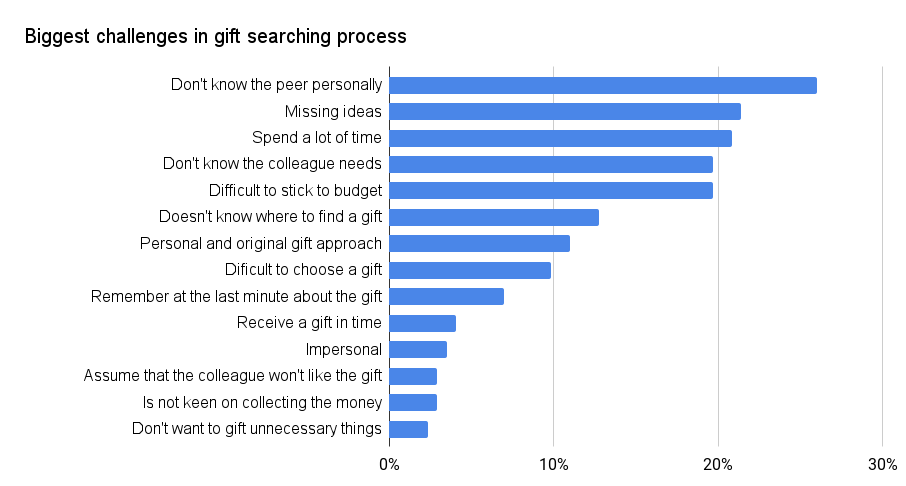
The biggest problem is that colleagues do not know their colleagues well enough to buy the best gift for them. A gift that is original and personal enough. Those who want to please a colleague want to find something special and that is not easy.
There are many challenges revolving around corporate gifting culture not only in Latvia, but globally. For example, a research conducted by Core Sight shows that the best way to easy these challenges is by simplifying the gifting culture. There should be a system in every business that makes giving gifts to colleagues easy and actually joyful.
Of course, we can also find typical problems, such as not being able to find where to buy the intended gift. Maybe even finding it difficult to stay within the set budget, or not liking the money-collecting process. For the last issue, we intend to compile the best answers we have found. As we believe we now have many ideas that may be valuable to you.
Where to find help with gift ideas
One of the most important challenges are related to choosing a gift. Here is data on where gift seekers turn for help.
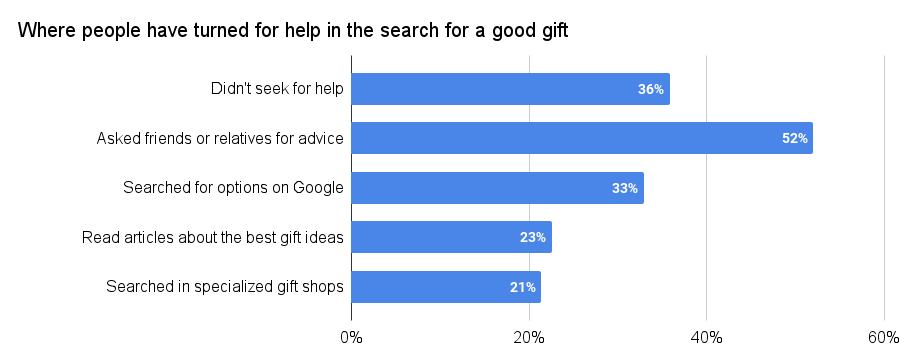
The most common source is the “a friend call”. That is a request for advice from someone who knows the person better. They then share useful information about what the colleague likes or wants.
More than half of the survey participants have used this type of help. It is frequently practiced to determine whether the colleague already has anything that the team intends to give. It’s also possible that the colleague’s friends or family will give the same gift on the same birthday.
People can also seek assistance from Google Advisor. Which is ready to assist with a range of suggestions that can be found in interesting articles.
Evaluation of the current system
The survey not only asked about the existing tradition of rewarding colleagues and employees. It also asked about how satisfied employees are with it.
It should be noted that many of the survey respondents were company managers, responsible for the gifts. Therefore the assessment is not definite. But overall, 63% of respondents are satisfied with the system. This is of course very pleasing!
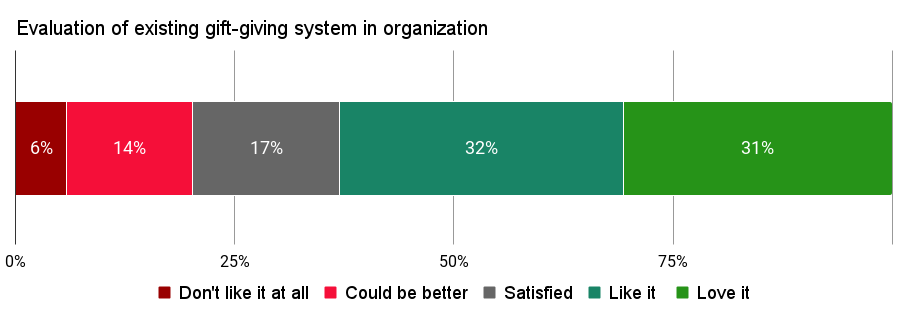
We will include more details on what employees are satisfied with and what they are not in a separate article.
We want to thank the FromMe.lv business for such an interesting and insightful survey. You can find more about gift giving culture on their page Gifts for employees, written in Latvian.
And of course thank you to all of the participants for giving their thoughts and ideas on how to improve the existing traditions. As well as what better ones could be introduced.
Please, leave a comment indicating which article you would like to see next:
- An analysis of the value of gifts by industry and who pays for the gift
- Different gifting traditions and what is gifted
- Satisfaction with the current system – what you like and what you don’t like
- The main challenges and recommendations for finding gifts
We hope this article was useful to you!
